- News
- Reviews
- Bikes
- Accessories
- Accessories - misc
- Computer mounts
- Bags
- Bar ends
- Bike bags & cases
- Bottle cages
- Bottles
- Cameras
- Car racks
- Child seats
- Computers
- Glasses
- GPS units
- Helmets
- Lights - front
- Lights - rear
- Lights - sets
- Locks
- Mirrors
- Mudguards
- Racks
- Pumps & CO2 inflators
- Puncture kits
- Reflectives
- Smart watches
- Stands and racks
- Trailers
- Clothing
- Components
- Bar tape & grips
- Bottom brackets
- Brake & gear cables
- Brake & STI levers
- Brake pads & spares
- Brakes
- Cassettes & freewheels
- Chains
- Chainsets & chainrings
- Derailleurs - front
- Derailleurs - rear
- Forks
- Gear levers & shifters
- Groupsets
- Handlebars & extensions
- Headsets
- Hubs
- Inner tubes
- Pedals
- Quick releases & skewers
- Saddles
- Seatposts
- Stems
- Wheels
- Tyres
- Health, fitness and nutrition
- Tools and workshop
- Miscellaneous
- Cross country mountain bikes
- Tubeless valves
- Buyers Guides
- Features
- Forum
- Recommends
- Podcast
news
Eurobike 2011 Cyclocross round up: Look, Lapierre, Cannondale, Colnago, Stevens, Ridley, Moots & a lot more
Next year's mildly anticipated explosion in cyclo-cross bikes hasn’t really happened, according to the halls of Eurobike at least, all the attention seems to have shifted towards 29er mountainbikes this year when it comes to dirt, right wheel size, but wrong diameter tyres and handlebars with the bend going the wrong way. Not cross, just mildly disappointed. Of course that doesn't mean there wasn't anything interesting to look at far from it.
Overall the cross bike showing at the, er, show was probably a bit down on the swell of possible next-big-thing-ness of last year, some manufacturers look to have disappeared the genre from their brochures altogether, whilst others have subtly condensed the line and one or two have expanded their range if only by just a wee bit, and there was a lot of same-as-last-time, without even so much as a new sticker, so overall a lack lustre, er, show then. Even the expected slew of disc-braked ‘cross bikes didn’t look to have stampeded the market either. Hmmm.
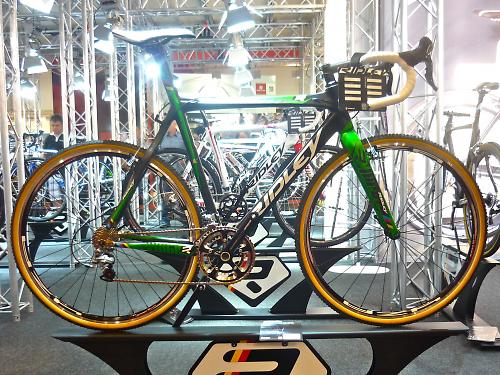
All the usual suspects where there, Euro brands Stevens and Ridley with their race-bred machines, the latter were sticking with cantilevers throughout their range and concentrating on aggressively shaped carbon podium-bothering machines while Stevens were hedging their bets in a canti/disc split with the Vapour disc-braked Ultegra equipped toy and showcasing the purposeful race-hungry World Champion model, a carbon framed seat-mast touting Di2 draped model that had “Prototype” hastily written on a bit of paper above it to suggest that enough people had asked already if they could buy it.
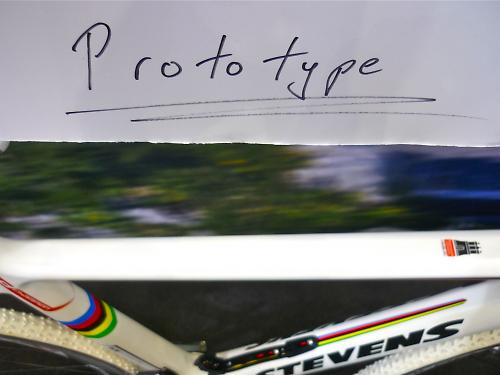
Focus had a pair each of their carbon and alloy bikes looking remarkably unchanged from last year but still chunky and eminently purposeful with some nice touches, cantilevered across the range with disc brakes being preferred on the hybrids, Kona’s stand had their hardy perennial Jake bikes, although their top-end carbon jobbie was MIA. Cannondale were being their usual fast and efficient selves with a simple duo, one carbon one aluminium, the plastic and string one featuring the SAVE rear end to ease arse-pounding over the hour while the metal one was a little less speed focused with handy rear rack mounts.

Rose were showing off their SRAM Force/Avid disc equipped Pro DX Cross model that was a new addition to their large range of canti-equiped CX bikes, whilst fellow Germans Cube had a couple of WYSIWYG models. The most exciting bikes came almost surprisingly from France with both Look and Lapierre showing off a sexy and chic little number each, the former had an “Oooooh, helllllllo” disc-braked beauty whilst the Lapierre was a carbon-masted Di2 equipped race dream machine. We’d happily take either for dinner in that nice little place on the Riviera. Whereas Specialized had bikes you’d take home to meet your mother in their Crux line, the cantilevered Crux Expert sporting a new full-cable run from the bottom-bracket to the rear-mech and a new Crux Comp Disc Apex almost embarrassingly hidden behind a display of bikes, their more sedate Tricross range was nowhere to be seen.

You-don’t-see-many-of-them brand Fuji had an unexpectedly funky and colourful carbon and Ultegra CX range topper in the Altamira, holding court over a triumvirate of alloy models. Pure carbon brand Isaac had a prototype crosser on their stand, despite looking all smart and well finished they said the details still needed ironing out, something they planned to do with feedback from riders and dealers, and they hinted that it wasn’t impossible that it would end up being a disc model instead of the canti-braked one on the stand. That’s a lot of ironing.

Merida had more disc-braked CX bikes on display than rim-stoppers, with the worryingly expensive Carbon Team-D and it’s internal-routed cables spearheading their charge into a possible future while Felt were manning up to newly sponsoring Ryan Trebon for this season by offering the carbon SRAM Red bedecked F3X and showing the aluminium F75X with 105 as an option for those without pro-contracts.
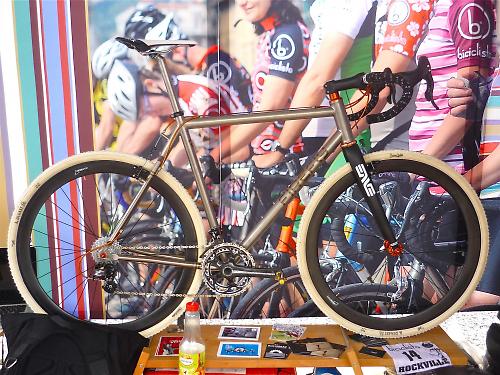
Sparsely sprinkled around the show were little moments of exotica from Cielo, Moots, a thigh-rubbing bike from Ti tubing joiners Firefly, and an eye-watering little orange affair with full-on matching Lightweight wheels from Berner. There were a few steel-is-the-new-black champions with Philadelphia’s Engin Cycles exercise in simplicity, a singlespeed CX bike that rarely for a ferrous bike had an integrated seat mast, and then there was the disc-braked sweetie from Crema Cycles, made in British Columbia by a guy that used to be a welder for Brodie bikes, the Rasenmäher can be custom built for cantis or discs. Ritchey had their “it’s not retro, we’ve always done it like this” steel SwissCross packed with those nice little trademark Ritchey minimalist details to make the ‘cross purist weaker at the knees than the hurdles on the last lap.

Throughout everyone’s CX ranges oversize headtubes were, um, big, with tapered headtubes and forks rapidly becoming the norm, at once both stiffening up the front end and helping reducing brake chatter with cantilevers, and bottom brackets have got chunkier across the board to accept all the new oversized BB standards.

Component wise Campagnolo were once again displaying their largely ignored CX specific kit, just like last year, with some simple looking cantilevers, and ‘cross specific chainsets, bottom-brackets and wheels that come with better seals than their road counterparts, which makes us wonder why the road bearings are so bad they need beefing up for ‘cross. Hmmm. In an obviously similar vein Campag. bedfellows Fulcrum where showing a set of better sealed road wheels and calling them CX specific. It took a keen eye, or someone grabbing you and taking you over to see the Reynolds disc ready 700C wheel, the Assault CX is based on their comparably monikered road wheel with its 46mm full-carbon rim but with a disc hub.
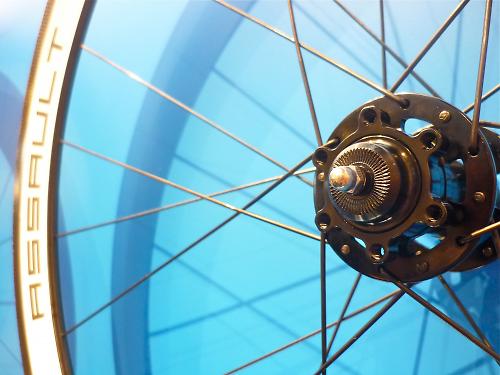
Enve had their carbon ‘cross forks tucked away in a corner and their cantilever pair was joined by a brand new full carbon fork looking forwards with a tapered steerer and being disc-brake only, and featuring a very neat integrated hose guide.
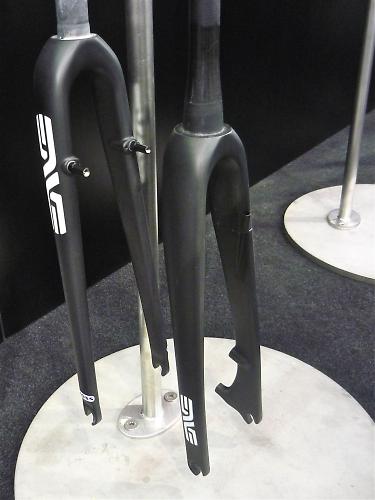
There was a little excitement in the tyre department, with a few more choices in which tyres to go sideways on for an hour. Vittoria were showing off the Cross XG Pro, a new tubeless specific CX tyre with a specially designed bead to grip the rim better at lower pressures and a tougher sidewall to resist cuts and punctures, addressing the most common failings when ghetto-tubelessing standard cyclo-cross tyres it looks a good alternative to those that are frightened by tubs. Continental had their usual range of cross rubber, Cyclocross, Cyclocross Race, Cyclocross Speed, Speed King and Cyclocross Plus tyres with both 700x35 and more whoomfy 45 width being available.

Vredestein had the Black Panther CX with a fast rolling centre tread and widely spaced knobs to the side. Kenda had a useful handful to choose from, most interestingly the new Slant 6, a blend of their fast but fragile Small Block 8 and mountainbikers favourite the Nevegal that looks to be good for a bit of everything. Specialized were also debuting some new tyres, the Tracer for fast all-round riding, the file-treaded Trigger for smooth hardpack and the widely spaced Terra for mud work. Hutchinson had their Toro CX and Piranha tyres sat in their usual corner. For faster, and maybe more towpathy work WTB had the Freedom Ryder, designed for the new breed of professional commuter and the Cross Wolf which was a whole bunch more aggressively treaded beast for real mud and grass duties.

Colnago had their aluminium World Cross 2.0 bike on their stand, with the trademark shoulder support, kitted out with cantilever brakes but rather tellingly ready for discs with tabs on the frame and fork, although looking at the catalogue the top-of-the-line carbon Prestige is cantilever only, if it’s good enough for Sven Nys… Which neatly highlights the warmest topic in cyclo-cross at the moment - discs or not?
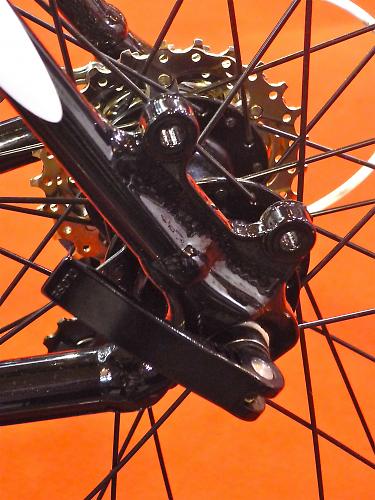
It’s worth remembering that the European market is a bit different to the one here in Blighty so Eurobike trends might not exactly mirror the UK scene. In Europe they use their cyclo-cross bikes for racing, and racing alone, and boy do they love their racing. Although CX racing in the UK is the healthiest it’s been for some time it’s still very much a three-men-and-a-dog spectator sport whereas in Europe it commands a massive and enthusiastic crowd with the top riders gathering fan-clubs, with beer. And while the race-scene is a persuasive force cyclo-cross bikes aren’t used so much as do-it-all commuter/tourer/roughstuff bikes like they are here, for that sort of pedaling the Euros use something hybridy, flat-barred and with easy-to-fit discs, because it’s more the right tool for the job, and because they seem to not have any stigma about not looking cool on a hybrid.

So maybe it’s no surprise that alongside the lack of a ‘cross bike explosion the expected outbreak of disc brakes hasn’t really erupted either, there were definitely more to see but it wasn’t a whitewash. The topic was one of much genteel discussion to those who cared however, with the future of discs on cyclo-cross bikes depending very much on whom you talked to. Some said the UCIs recentish decision to allow disc brakes in top competition came too late in the manufacturing year for most bike makers to implement the necessary changes for this model year and it was all going to kick off next season. Others said discs would never make it into the upper echelons of racing where cantis were going to reign thanks to their light weight and basic ability to just scrub off a bit of speed, which was all that was needed for an hour, but ‘normal’ people would use them for racing and just mucking about on. Then again others said that everyone would be using them within the next 6 months from pro level downwards. Racers would milk the benefits of both the predictable stopping whatever the weather and being able to brake later into the corners which can come in handy, and braking being done in the middle of the wheel would enable them to use lighter rims, and/or carbon hoops that didn’t need to be beefed up with a mud resistant braking surface, while everyday users could enjoy the lack of maintenance, predictable braking at all speeds and a lack of that crappy brake grime pooling on the bike and carpet.
But it felt like no-one really knew how this possible disc future would pan out and people were just shuffling about a bit until someone made a bold move. A decision not helped by existing cable disc-brakes being heavy and consistently awkward to keep working predictably, something that could be sorted in one easy swoop by a hydraulic road brake, if only someone would make one. Again it depended on whom you talked to as to whether that would happen, some said the big manufacturers would never bother making a hydraulic road lever as the market was just too small in cyclo-cross and the behemoth road market didn’t need or want one, others said something would be along in a few months, and tapped their noses conspiratorially.

So with no-one coming out with an integrated hydraulic road lever just yet despite plenty of people dreaming that with the arrival of Di2 and the empty space that the removal of all the mechanical gubbins left in the brake hood there was hope that someone, anyone, would and could fill that internal hole with a hydraulic reservoir and a neat and simple hydraulic braking solution, free from the vagaries and peccadilloes of cable discs the problem of linking a standard brake lever to a hydraulic brake was being addressed by a trio of adaptors. Trickstuff, TRP and Hope all had cable-to-hydro adaptors to fill the gap until something more integrated pops out the woodwork. The Trickstuff Doppelmoppel unit has been around a while and we’ve only ever seen it at bike shows, CNC-ed and looking pretty, er, trick in that homemade way but it looks like it may suffer from a Winter’s racing as a large amount of it’s workings are exposed to the elements, something even the newer and more refined and Eurobike Award winning TRP Parabox suffers from with it’s exposed wires and bolts and cams. Hope’s brand new (unless you count the one they made over a decade ago) cable-hydro converter unit wins on this count with no exposed moving parts that could be contaminated by muck and grime and it looks the most finished, even if it is still in final prototype stage. In the Heath Robinson corner we stumbled across the little DBikes booth and their cable to hydraulic fix where the cables from the brake levers simply thread straight into the levers of a set of Magura hydraulic MTB brakes set up in the style of cissy-levers on the tops of the bars. Pulling on the road levers simply hauled the hydraulic brake levers, top marks for, um, garage bodge. Moving swiftly on...

As a footnote there was a little less of the fudging of the boundaries between a ‘cross bike, a touring bike, a monster-cross and a drop-barred 29er than previously, but we always have time for something that we’re not sure what it is, but that ticks enough boxes to want anyway, and this year it was the Surly Disc Trucker, an update on the popular Long Haul Trucker. It wears its wilderness dependability and do-it-all happily and heartily on it’s sleeve, available in either 26’” or 700c wheels in good old steel with a spoke-holder on the seat-stay and work-even-when-broken bar-end shifters it made us uncertain how to categorise it, but it made us just want to go for a ride until cyclo-cross knows where to go next.
Oh, and we've got even more cyclocross newness to look at in our second gallery of cyclocross 2012 pics… more on that coming soon.
Jo Burt has spent the majority of his life riding bikes, drawing bikes and writing about bikes. When he's not scribbling pictures for the whole gamut of cycling media he writes words about them for road.cc and when he's not doing either of those he's pedaling. Then in whatever spare minutes there are in between he's agonizing over getting his socks, cycling cap and bar-tape to coordinate just so. And is quietly disappointed that yours don't He rides and races road bikes a bit, cyclo-cross bikes a lot and mountainbikes a fair bit too. Would rather be up a mountain.
Latest Comments
- wtjs 7 sec ago
The easiest and probably best way of incorporating your 'the 4% of drivers who do not abhor close-passing are not quite as malevolent as they...
- Jimthebikeguy.com 19 min 50 sec ago
For normal people, the ratios on a grx double are perfect, allied to a whacking great cassette. Because nobody needs to actually ride TDF pro gearing.
- HoarseMann 35 min 14 sec ago
Apple Maps verdict from me… complete fail....
- Rendel Harris 1 hour 13 min ago
Yep, that's why 70% of World Tour teams are using Shimano, those people are really noted for not wanting the best kit, they'll take any old crap.
- Bmblbzzz 1 hour 58 min ago
"A brutalist interpretation of a road" So true. Grey markings on grey paving slabs surrounded by other grey paving slabs...
- Simon E 1 hour 42 min ago
Driver in a Citroen travelling at 70mph crashes into the front of a house in Canterbury Road, Faversham at 5.30am on Sunday....
- arichman 2 hours 31 min ago
Somewhat confusingly, Velocio includes both a fit and a size chart, and says to use the fit chart (which uses height and weight) as the guide for...
- wtjs 3 hours 52 min ago
I can't find anbody else with this problem, so I'm putting it here. I went to visit a friend near Chester, using the excellent Merseyrail cycle...




































































































Add new comment
1 comments
cx bike pron... I like.
Interesting to read that the 29er thing is the trend of the year but not entirely surprised. I think its a much easier sell to the average punter than any drop bar bike.